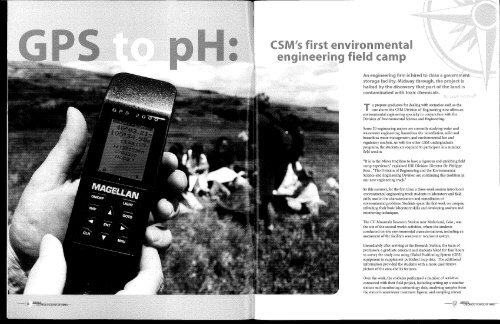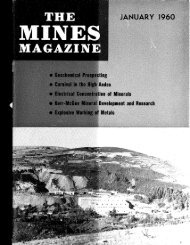Mines Magazine - Colorado School of Mines
Mines Magazine - Colorado School of Mines
Mines Magazine - Colorado School of Mines
Create successful ePaper yourself
Turn your PDF publications into a flip-book with our unique Google optimized e-Paper software.
T<br />
o prepare graduates for dealing with scenarios such as the<br />
one above, the CSM Division <strong>of</strong> Engineering now <strong>of</strong>fers an<br />
envkonmental engineering specialty in conjunction with the<br />
Division <strong>of</strong> Environmental Science and Engineering.<br />
Some 20 engineering majors are currently studying water and<br />
wastewater engineering, hazardous site remediation, solid and<br />
hazardous waste management, and environmental law and<br />
regulatory analysis. As with the other CSM undergraduate<br />
programs, the students are required to participate in a summer<br />
field session.<br />
"It is in the <strong>Mines</strong> tradition to have a rigorous and enriching field<br />
camp experience," explained ESE Division Director Dr. Plufippe<br />
Ross . "The Division <strong>of</strong> Engineering and the Environmental<br />
Science and Engineering Division are continuing this tradition in<br />
our new engineering track."<br />
So this summer, for the first time, a three-week session introduced<br />
environmental engineering track students to laboratory and field<br />
skills used in the characterization and remediation <strong>of</strong><br />
environmental problems. Students spent the first week on campus,<br />
refreshing their basic laboratory skills and developing analysis and<br />
monitoring techniques.<br />
The CU Mountain Research Station near Nederland, Colo., was<br />
the site <strong>of</strong> the second week's activities, where the students<br />
conducted on-site environmental characterizations, including an<br />
assessment <strong>of</strong> the facility's wastewater treatment system.<br />
Immediately after arriving at the Research Station, the team <strong>of</strong><br />
pr<strong>of</strong>essors, a graduate assistant and students hiked for four hours<br />
to survey the study area using Global Positioning System (GPS)<br />
equipment to supplement pubfished map data. The additional<br />
information provided the students with a more quantitative<br />
picture <strong>of</strong> the area and its features.<br />
Over the week, the students performed a number <strong>of</strong> activities<br />
connected with their field project, including setting up a weather<br />
station and monitoruig meteorology data, analyzing samples from<br />
the station's wastewater treatment lagoon, and sampling stream<br />
7 "^'^ERArjO SCHOOLOFMINES

















